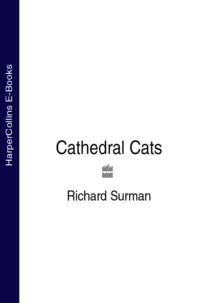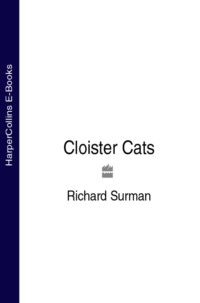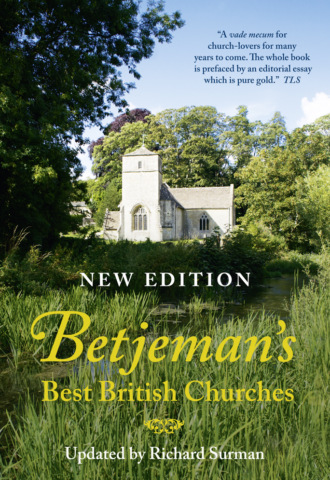
Полная версия
Betjeman’s Best British Churches

BETJEMAN’S BEST BRITISH CHURCHES
UPDATED BY RICHARD SURMAN
With photographs by Michael Ellis and Richard Surman

Contents
Cover
Title Page
How to find a Church
County Locator
PREFACE by Richard Surman
INTRODUCTION by Sir John Betjeman
ENGLAND BY COUNTY
BEDFORDSHIRE
BERKSHIRE
BUCKINGHAMSHIRE
CAMBRIDGESHIRE
CHESHIRE
CORNWALL
CUMBRIA
DERBYSHIRE
DEVON
DORSET
DURHAM
ESSEX
GLOUCESTERSHIRE
HAMPSHIRE & THE ISLE OF WIGHT
HEREFORDSHIRE
HERTFORDSHIRE
KENT
LANCASHIRE, MERSEYSIDE & GREATER MANCHESTER
LEICESTERSHIRE
LINCOLNSHIRE
LONDON
GREATER LONDON
NORFOLK
NORTHAMPTONSHIRE
NORTHUMBERLAND AND TYNE & WEAR
NOTTINGHAMSHIRE
OXFORDSHIRE
RUTLAND
SHROPSHIRE
SOMERSET & BRISTOL
STAFFORDSHIRE
SUFFOLK
SURREY
SUSSEX – EAST
SUSSEX – WEST
WARWICKSHIRE & WEST MIDLANDS
WILTSHIRE
WORCESTERSHIRE
YORKSHIRE – EAST RIDING
YORKSHIRE – NORTH
YORKSHIRE – SOUTH
YORKSHIRE – WEST
WALES
SCOTLAND
THE ISLE OF MAN
THE CHANNEL ISLANDS
Glossary
Index of Architects and Artists
Index of Places
Acknowledgements
Copyright
About the Publisher
How to find a Church
This book includes Ordnance Survey (OS) and Global Positioning System (GPS) coordinates to help readers locate the churches with precision.
USING THE OS COORDINATES
The OS grid references work on all the paper Ordnance Survey maps and the Ordnance Survey’s OpenData service on its website (www.ordnancesurvey.co.uk). If using the website, simply type the full grid reference into the OpenData search bar – e.g. SE966710 – which will take you directly to a map page showing the church, usually identifiable as ‘PW’ for ‘place of worship’.
If you are using an Ordnance Survey paper map, the same six-digit grid reference will work as follows:
• THE FIRST TWO LETTERS – e.g. the SE of SE966710 – refer to the Ordnance Survey’s division of Great Britain into 100 x 100 km major grid squares, each identified by two letters. On the paper maps, the letters can be seen in large lettering in the corner 1km grid squares and also where the major squares butt up to each other.
• THE FIRST TWO DIGITS – e.g. 96 – refer to the horizontal grid lines, called the ‘eastings’, which are numbered left to right on the paper maps.
• THE THIRD DIGIT – e.g. 6 – refers to the eastings grid in tenths. Thus the 6 in this example is six-tenths east of grid line 96.
• THE FOURTH AND FIFTH DIGITS – e.g. 71 – refer to the vertical grid lines, called the ‘northings’, which are numbered bottom to top on the paper maps.
• THE SIXTH DIGIT – e.g. 0 – refers to the northings grid in tenths. Thus the 0 in this example is within one-tenth north of grid line 71.
The division of tenths on the six-digit OS references in this book should be accurate to within 100 metres of the church.
USING THE GPS COORDINATES
These references give the latitude and longitude of locations in a digital format used by many car SatNav systems, mobile devices with GPS, and major online mapping applications such as Google and Bing.
Car SatNavs
First check if your SatNav allows the input of latitude and longitude / GPS coordinates. There are several reference systems in operation, so select ‘digital’ if given the option. In some SatNavs you will need to key in the full GPS coordinates with letters – e.g. 54.12669N, 0.52226W – while in others the letters may have to be selected separately.
Note that the GPS coordinates given in this book are centred on the church building itself, rather than an access point into the grounds or the nearest car park. Churches sited in remote fields, woods or parks may be some distance from the nearest public highway, and in such cases SatNavs won’t necessarily guide you to the best access point or parking place, although they should indicate where the church stands.
If your car SatNav does not offer the option to input the coordinates, we would suggest that you search for the village name and then the church name as a point of interest within the village, or, failing that, searching for ‘Church Street’ in a village often yields results!
Google Maps and Bing
Google Maps, Bing and some other online maps directly read the digital coordinates given in this book. Simply type the coordinates – e.g. 54.12669N, 0.52226W – into the map’s search bar.
Mobile phones and Other GPS Devices
Handheld devices that support GPS can read the GPS coordinates. On an iPhone, BlackBerry or Android device, for example, open the Google Maps application and type the coordinates into the search bar. Devices that use Full GPS (linking directly to satellites) are more accurate than those using Assisted GPS (via mobile phone masts).
If your device does not recognize the letters in the references, try leaving out the letters and substituting a minus sign before the longitude reference – e.g. 54.12669, -0.52226. (The minus sign is not necessary for longitude references ending in E.)
County Locator
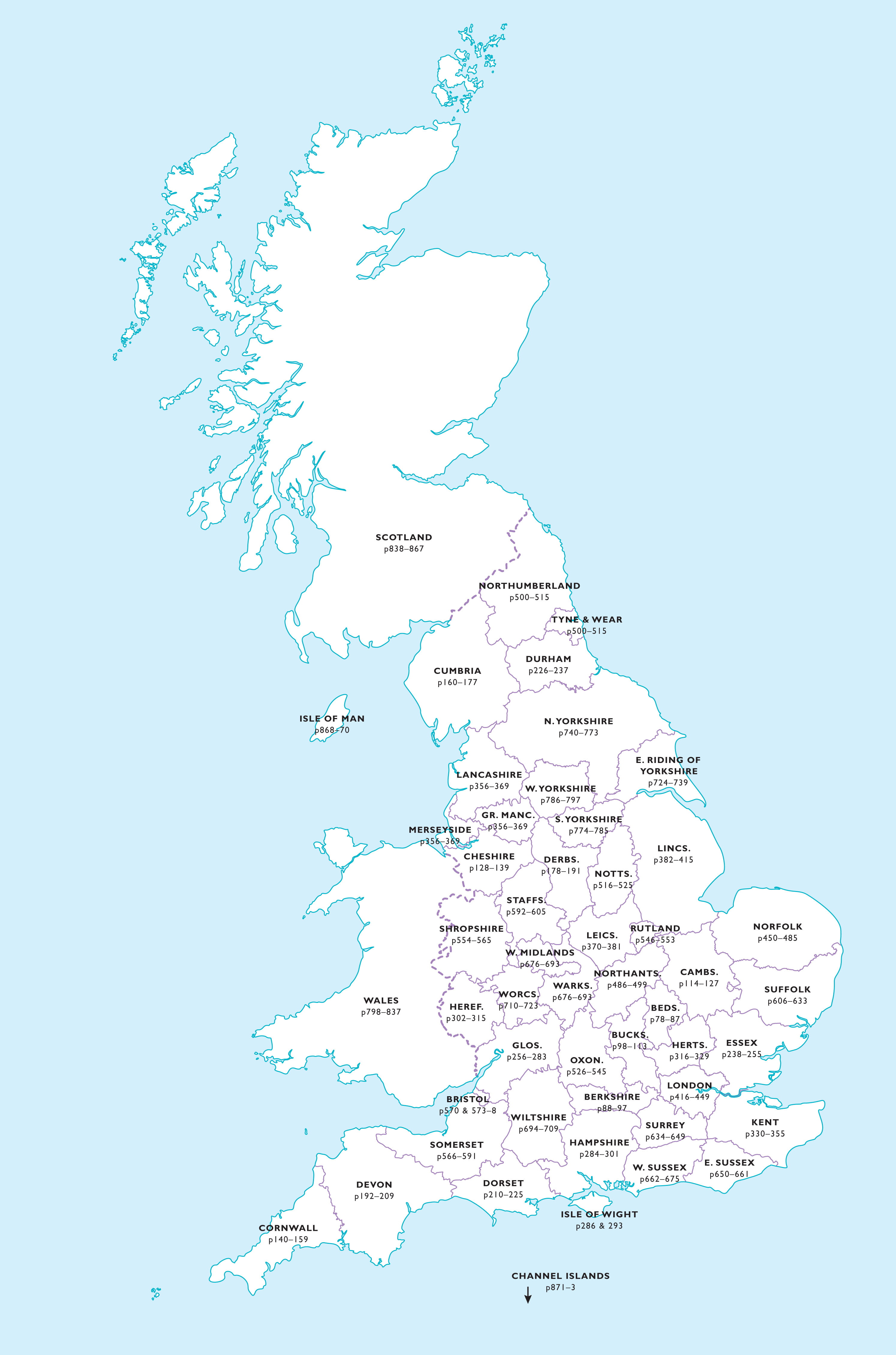
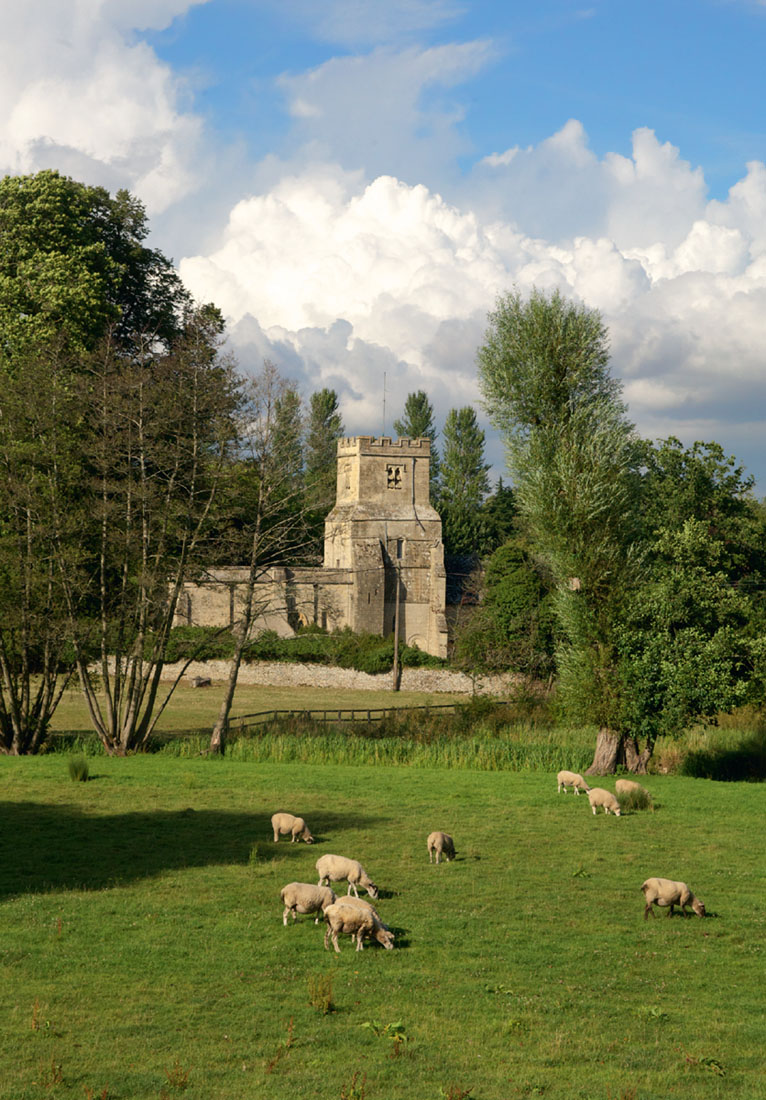
COLN ST DENYS: ST JAMES THE GREAT – sunk into the picturesque Gloucestershire landscape, the church retains its Norman ground plan and tower
© Richard Surman
PREFACE by Richard Surman
Since John Betjeman compiled the first 1958 edition of the Collins Guide to English Parish Churches, it has become a classic of its kind, and has been reprinted several times, most notably in the two-volume Collins Pocket Guide to English Parish Churches, published in 1968, and the 1980 edition, in which the scope of the book was extended to take in churches in Wales. The background to the book is a story all of its own. To many, Sir John Betjeman was latterly the Poet Laureate, whose work was reviled and adored in equal measure. But Betjeman was many things apart from being a poet: as a young boy holidaying in Trebetherick he went church-hunting, and in adolescence, churches became a passion for him. He would always talk about his childhood impressions of buildings as being crucial in determining his later responses to architecture.
Friendships with James Lees-Milne, the noted architectural advisor to the National Trust, Betjeman’s work on the Architectural Review, where he met and formed a life-long friendship with the artist John Piper, a spell as the film critic for the Evening Standard – all these fed Betjeman’s limitless and sometimes mischievous imagination, which was equally exercised by his colourful private life.
His working life would take a different emphasis however, when he proposed the idea of a series of county guides to Jack Beddington, publicity manager of Shell-Mex BP. Beddington was known for his patronage of artists and writers, and Betjeman found himself working alongside Paul Nash and a coterie of friends to whom he handed out work on the Shell Guide series. What always characterised Betjeman’s reactions to architecture and countryside was a sense of place – the setting – as well as architectural and topographical detail. However mannered Betjeman might sometimes appear, one of his great gifts was to let landscape, architecture and art speak for themselves. After the war, Betjeman worked on many magazines, as well as writing poetry, and appearances on television became more and more regular. His presenting of the ABC of Churches programmes was a great success, not least to the crew, with whom he got on famously (although he did disconcert at least one member of the crew by taking his teddy bear Archibald Ormsby Gore wherever he went).
This new version – Betjeman’s Best British Churches – takes Betjeman’s original idea and moves it in a slightly different direction, but with great respect for his fundamental love of parish churches. The volume has much of a 21st-century feel about it – the age of satellite navigation and precision mapping have allowed us to create very precise locations for each of the churches featured herein. Betjeman would have found this odd, I’m sure, but it is our hope that in ‘modernising’ the format of the book, we might appeal to a new audience more familiar with the digital age, as well as re-invigorating those familiar with earlier versions.
There are three radical departures from previous editions. The first is that we have introduced a much stronger pictorial element: full colour photographs are used throughout the book, as are accurate and clear maps of each county. The second radical difference arises from the first: with a large number of colour illustrations, the extent of the book has had to be considerably reduced. Betjeman’s original book contained some 4,500 entries, and in some respects was a gazetteer. We decided to considerably modify this present edition, cutting down to some 2,500 entries. The criterion for retaining entries has been, wherever possible, to refer to the very simple star system that Betjeman employed in the 1968 edition, as the basis for first selection. Although the most recent 1993 edition discarded this form of rating, we have re-introduced it here, refining it so that throughout the book there is now a one- and two-star rating. Naturally there are many other churches included that were not starred in Betjeman’s 1968 edition – some of those have been revised too. There are also new churches included, and to these we have applied rating criteria that reflect those of which Betjeman would have approved.
The third radical departure from previous versions is the creation of an entirely new section for Scotland. Though Scottish religious history differs quite significantly from that of England and Wales, we believe that there is a sufficient number of fine churches in Scotland to merit a place alongside their English and Welsh counterparts.
Another distinct feature of this present book is the inclusion of several notable Roman Catholic churches: these have been selected as being of outstanding historical, architectural or artistic merit. The medieval abbey of Pluscarden in Scotland qualifies on both counts, first as the only medieval monastery in the British Isles in continuous use – barring a hiatus after the Reformation – by a Roman Catholic monastic community, and second as a centre of design and production of outstanding contemporary glass. The Church of the Immaculate Conception, Farm Street, London has an entry, based on the excellent work of A. W. N. Pugin to the altar and reredos and the chancel chapels by H. Clutton and J. F. Bentley. London’s Brompton Oratory gets an entry too; it would be remiss to ignore this extraordinary piece of Rome in London. In common with earlier editions we have also included churches in the care of the excellent Churches Conservation Trust, the Friends of Friendless Churches – especially in Wales – and English Heritage.
As regards the structure of counties, we have followed all the modern ceremonial boundaries: this has necessitated a considerable re-ordering of Yorkshire, the merging of Westmorland and Cumberland into Cumbria, changes to Berkshire and Oxfordshire and several other counties. Rutland, the country’s smallest and fiercely independent county, has been retained, whilst Huntingdonshire and the Soke of Peterborough have been brought together within Cambridgeshire. Bristol is with Somerset, and London is in two parts, Central and Greater London (the latter containing Middlesex and the inner parts of Essex, Kent and Surrey). Greater Manchester and Merseyside are together with Lancashire.
Considerable effort has gone into checking the facts about each entry, and wherever possible we have corrected errors. For errors that we have inadvertently introduced or have failed to correct, we both apologise and welcome comments.
To those people who may be disconcerted by the disappearance from this edition of their familiar churches, we ask for their forbearance, and hope that we have explained with sufficient persuasion the reasons why. Above all what we have striven to achieve is a book that captures the spirit of the earlier editions, in a 21st-century context.
A book such as this is not possible without the work of many people, not least those who have contributed to the various counties over the years. In particular I would like to thank Sam Richardson and Helena Nicholls at Collins Reference for their enthusiastic support for a long and complex project. I would also like to express my gratitude to Mike and Ros Ellis at Thameside Media: their hard and painstaking work on the planning, design, mapping, checking and photography have been essential. Their enthusiasm and expertise has taken them, I suspect, way beyond their brief. I am also very grateful to Michael Lynch, former Sir William Fraser Professor of Scottish History and Palaeography, for his eagle-eyed and helpful observations on my attempts to disentangle Scottish religious history.
Many others have contributed more indirectly – those hard-working souls that keep (some) of our fine churches open, that write the individual church guides, many of which are of a very high standard, and the various organisations, particularly the Churches Conservation Trust, the Friends of Friendless Churches, the National Churches Trust and the many county historic church trusts, all of whom work tirelessly to preserve a priceless heritage – the parish church.
Richard Surman 2011

WALPOLE ST PETER: ST PETER – the porch to the church is vaulted in a beautiful sandstone, the bosses sculpted into the sleeping forms of foals, sheep and suchlike
© Michael Ellis
INTRODUCTION by Sir John Betjeman
PART ONE: THE OLD CHURCHES
To atheists inadequately developed building sites; and often, alas, to Anglicans but visible symbols of disagreement with the incumbent: ‘the man there is “too high”, “too low”, “too lazy”, “too interfering”’ – still they stand, the churches of England, their towers grey above billowy globes of elm trees, the red cross of St George flying over their battlements, the Duplex Envelope System employed for collections, schoolmistress at the organ, incumbent in the chancel, scattered worshippers in the nave, Tortoise stove slowly consuming its ration as the familiar 17th-century phrases come echoing down arcades of ancient stone.
Odi et amo. This sums up the general opinion of the Church of England among the few who are not apathetic. One bright autumn morning I visited the church of the little silver limestone town of Somerton in Somerset. Hanging midway from a rich-timbered roof, on chains from which were suspended branched and brassy-gleaming chandeliers, were oval boards painted black. In gold letters on each these words were inscribed:
TO GOD’S
GLORY
&
THE HONOR OF
THE
CHURCH OF
ENGLAND
1782
They served me as an inspiration towards compiling this book.
The Parish Churches of England are even more varied than the landscape. The tall town church, smelling of furniture polish and hot-water pipes, a shadow of the medieval marvel it once was, so assiduously have Victorian and even later restorers renewed everything old; the little weather-beaten hamlet church standing in a farmyard down a narrow lane, bat-droppings over the pews and one service a month; the church of a once prosperous village, a relic of the 15th-century wool trade, whose soaring splendour of stone and glass subsequent generations have had neither the energy nor the money to destroy; the suburban church with Northamptonshire-style steeple rising unexpectedly above slate roofs of London and calling with mid-Victorian bells to the ghosts on the edge of the industrial estate; the High, the Low, the Central churches, the alive and the dead ones, the churches that are easy to pray in and those that are not, the churches whose architecture brings you to your knees, the churches whose decorations affront the sight – all these come within the wide embrace of our Anglican Church, whose arms extend beyond the seas to many fabrics more.
From the first wooden church put up in a forest clearing or stone cell on windy moor to the newest social hall, with sanctuary and altar partitioned off, built on the latest industrial estate, our churches have existed chiefly for the celebration of what some call the Mass, or the Eucharist and others call Holy Communion or the Lord’s Supper.
Between the early paganism of Britain and the present paganism there are nearly twenty thousand churches and well over a thousand years of Christianity. More than half the buildings are medieval. Many of those have been so severely restored in the last century that they could almost be called Victorian – new stone, new walls, new roofs, new pews. If there is anything old about them it is what one can discern through the detective work of the visual imagination.
It may be possible to generalize enough about the parish church of ancient origin to give an impression of how it is the history of its district in stone and wood and glass. Such generalization can give only a superficial impression. Churches vary with their building materials and with the religious, social and economic history of their districts.
The Outside of the Church – Gravestones
See on some village mount, in the mind’s eye, the parish church of today. It is in the old part of the place. Near the church will be the few old houses of the parish, and almost for certain there will be an inn very near the church. A lych-gate built as a memorial at the beginning of this century indicates the entrance to the churchyard. Away on the outskirts of the town or village, if it is a place of any size, will be the arid new cemetery consecrated in 1910 when there was no more room in the churchyard.
Nearer to the church and almost always on the south side are to be found the older tombs, the examples of fine craftsmanship in local stone of the Queen Anne and Georgian periods. Wool merchants and big farmers, all those not entitled to an armorial monument on the walls inside the church, generally occupy the grandest graves. Their obelisks, urns and table tombs are surrounded with Georgian ironwork. Parish clerks, smaller farmers and tradesmen lie below plainer stones. All their families are recorded in deep-cut lettering. Here is a flourish of 18th-century calligraphy; there is reproduced the typeface of Baskerville. It is extraordinary how long the tradition of fine lettering continued, especially when it is in a stone easily carved or engraved, whether limestone, ironstone or slate. The tradition lasted until the middle of the 19th century in those country places where stone was used as easily as wood. Some old craftsman was carving away while the young go-aheads in the nearest town were busy inserting machine-made letters into white Italian marble.
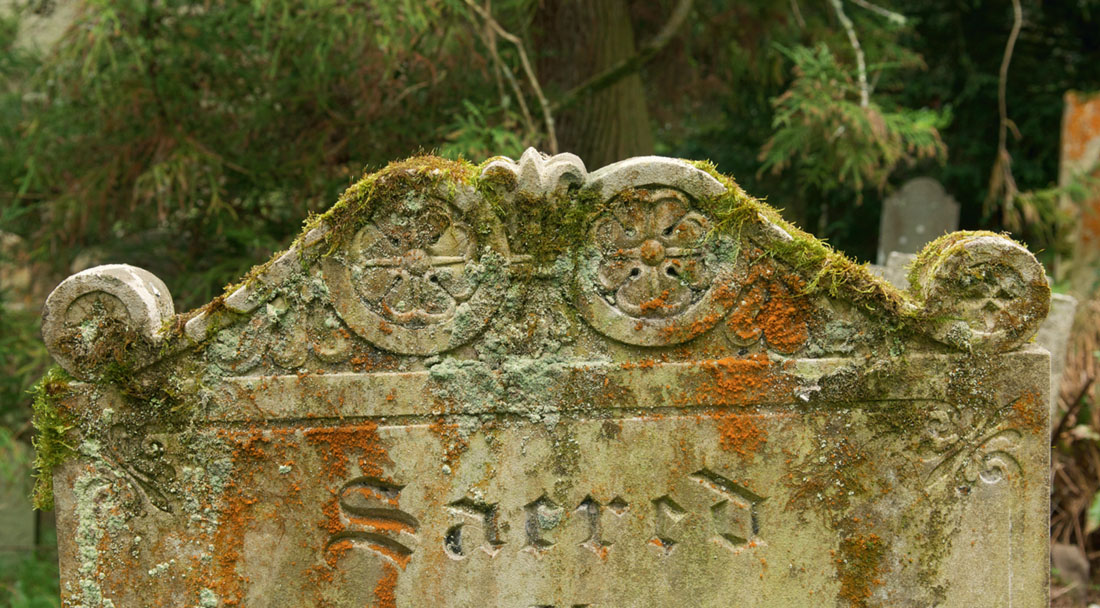
ST JUST-IN-ROSELAND: ST JUST – coastal lichen and moss on one of the headstones
© Michael Ellis
The elegance of the local stone carver’s craft is not to be seen only in the lettering. In the 18th century it was the convention to carve symbols round the top of the headstone and down the sides. The earlier examples are in bold relief, cherubs with plough-boy faces and thick wings, and scythes, hour glasses and skulls and cross-bones diversify their tops. You will find in one or another country churchyard that there has been a local sculptor of unusual vigour and perhaps genius who has even carved a rural scene above some well-graven name. Towards the end of the 18th century the lettering becomes finer and more prominent, the decoration flatter and more conventional, usually in the Adam manner, as though a son had taken on his father’s business and depended on architectural pattern-books. But the tops of all headstones varied in shape. At this time too it became the custom in some districts to paint the stones and to add a little gold leaf to the lettering. Paint and stone by now have acquired a varied pattern produced by weather and fungus, so that the stones are probably more beautiful than they were when they were new, splodged as they are with gold and silver and slightly overgrown with moss. On a sharp frosty day when the sun is in the south and throwing up the carving, or in the west and bringing out all the colour of the lichens, a country churchyard may bring back the lost ages of craftsmanship more effectively than the church which stands behind it. Those unknown carvers are the same race as produced the vigorous inn signs which were such a feature of England before the brewers ruined them with artiness and standardization. They belong to the world of wheelwrights and wagon-makers, and they had their local styles. In Kent the chief effect of variety was created by different-sized stones with elaborately-scalloped heads to them, and by shroud-like mummies of stone on top of the grave itself; in the Cotswolds by carving in strong relief; in slate districts by engraved lettering. In counties like Surrey and Sussex, where stone was rare, there were many wooden graveyard monuments, two posts with a board between them running down the length of the grave and painted in the way an old wagon is painted. But most of these wooden monuments have perished or decayed out of recognition.
‘At rest’, ‘Fell asleep’, ‘Not dead but gone before’ and other equally non-committal legends are on the newer tombs. In Georgian days it was the custom either to put only the name or to apply to the schoolmaster or parson for a rhyme. Many a graveyard contains beautiful stanzas which have not found their way to print and are disappearing under wind and weather. Two of these inscriptions have particularly struck my fancy. One is in Bideford and commemorates a retired sea-captain Henry Clark, 1836. It summarizes for me a type of friendly and pathetic Englishman to be found hanging about, particularly at little seaports.
For twenty years he scarce slept in a bed;
Linhays and limekilns lull’d his weary head
Because he would not to the poor house go,
For his proud spirit would not let him to.
The black bird’s whistling notes at break of day
Used to wake him from his bed of hay.
Unto the bridge and quay he then repaired
To see what shipping up the river stirr’d.
Oft in the week he used to view the bay,
To see what ships were coming in from sea,
To captains’ wives he brought the welcome news,
And to the relatives of all the crews.
At last poor Harry Clark was taken ill,


